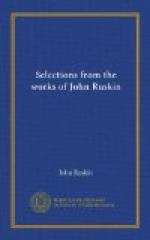I would have, then, our ordinary dwelling-houses built to last, and built to be lovely; as rich and full of pleasantness as may be, within and without; with what degree of likeness to each other in style and manner, I will say presently, under another head;[164] but, at all events, with such differences as might suit and express each man’s character and occupation, and partly his history. This right over the house, I conceive, belongs to its first builder, and is to be respected by his children; and it would be well that blank stones should be left in places, to be inscribed with a summary of his life and of its experience, raising thus the habitation into a kind of monument, and developing, into more systematic instructiveness, that good custom which was of old universal, and which still remains among some of the Swiss and Germans, of acknowledging the grace of God’s permission to build and possess a quiet resting-place, in such sweet words as may well close our speaking of these things. I have taken them from the front of a cottage lately built among the green pastures which descend from the village of Grindelwald to the lower glacier:—
Mit herzlichem Vertrauen
Hat Johannes Mooter und Maria
Rubi
Dieses Haus bauen lassen.
Der liebe Gott woll uns bewahren
Vor allem Unglueck und Gefahren,
Und es in Segen lassen stehn
Auf der Reise durch diese
Jammerzeit
Nach dem himmlischen Paradiese,
Wo alle Frommen wohnen,
Da wird Gott sie belohnen
Mil der Friedenskrone
Zu
alle Ewigkeit.[165]
In public buildings the historical purpose should be still more definite. It is one of the advantages of Gothic architecture,—I use the word Gothic in the most extended sense as broadly opposed to classical,—that it admits of a richness of record altogether unlimited. Its minute and multitudinous sculptural decorations afford means of expressing, either symbolically or literally, all that need be known of national feeling or achievement. More decoration will, indeed, be usually required than can take so elevated a character; and much, even in the most thoughtful periods, has been left to the freedom of fancy, or suffered to consist of mere repetitions of some national bearing or symbol. It is, however, generally unwise, even in mere surface ornament, to surrender the power and privilege of variety which the spirit of Gothic architecture admits; much more in important features—capitals of columns or bosses, and string-courses, as of course in all confessed has-reliefs. Better the rudest work that tells a story or records a fact, than the richest without meaning. There should not be a single ornament put upon great civic buildings, without some intellectual intention. Actual representation of history has in modern times been checked by a difficulty, mean indeed, but steadfast; that of unmanageable costume: nevertheless, by a sufficiently bold imaginative treatment,




